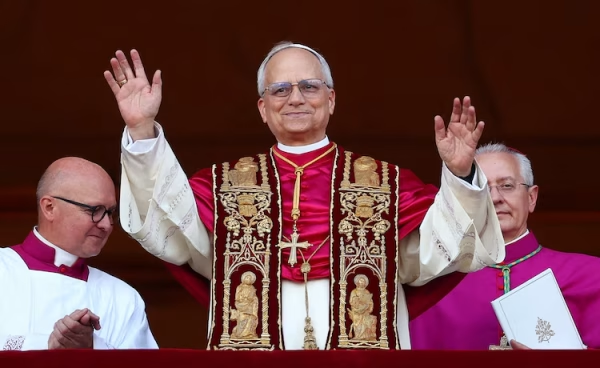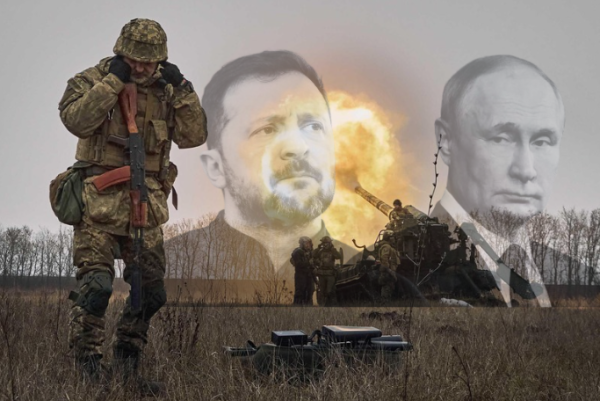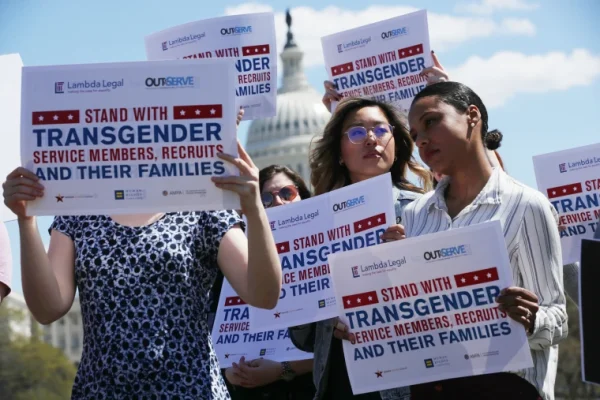The Russo-Ukrainian Conflict One Year Later
In December 1991, the grip of the Soviet Union’s communist regime fell. The Union of Soviet Socialist Republics was officially dissolved, creating 15 ‘new’ countries. I put new in quotations because these countries are most definitely not new. Many of these countries had an extensive history before Russia incorporated them into their Union, and many of these countries have had violent relationships with one another.
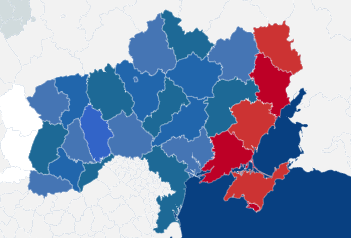
Red: Oblasts with Russian occupation.
Blue: Oblasts held by Ukraine.
But one example has recently been very prominent in the media: Ukraine and Russia. Ukraine consists of 24 oblasts (provinces), five of which Russia showed deep interest in. These five provinces were the autonomous republic of Crimea, the federal city of Sevastopol which were illegally annexed in 2014, and Luhansk, Donetsk, Zaporizhzhia, and Kherson were ‘annexed’ in September of 2022.
Ukraine is an Eastern European nation and the former Soviet Republic that has a sizeable Russian population on the Eastern side of the country. But over one year ago now, in the early morning of the 24th of February 2022, Putin launched a full-scale invasion of Ukraine which he deemed a “special military operation” for the “demilitarisation and denazification” of the country. This is the largest invasion that has taken place in Europe since the Second World War.
To understand the conflict as a whole, we will split the conflict into four individual phases. Phase one, which is the initial Russian invasion (February 28 – March 25), phase two, Russia redirects its focus to a southeastern offensive of Ukraine (March 26 – August 28), phase three, the Ukrainian counteroffensive of Russia (29 August – 11 November), and phase four, the second stalemate (November 12, 2022 – Present) alongside predictions of what may happen in the future.
The Russian Invasion (February 28 to March 25, 2022)
February 2022
On the 28th of February, 2022, following months of heavy Russian military presence on the border of Ukraine, the Russian military invaded from three sides, Northern Ukraine towards the capital city, Kyiv, Southern Ukraine through the Crimean Peninsula toward Kherson, and Eastern Ukraine through the Donbas Region. Putin and other Russian military officials estimated that they would seize control of Ukraine in a matter of three days. However, as we now know, this has since resulted in utter disaster for the Russians.
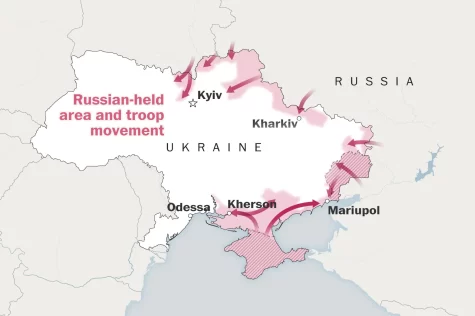
Some notable events of February include the Battle of Kyiv. Where for days, the Russians swiftly gained territory and were mere miles away from the critical capital city. The Russians continuously performed artillery barrages on the city and, according to a statement released by BBC News in December of 2022, the Ukrainian government estimated that the number of deaths in the Battle of Kyiv alone ranged anywhere from “10,000 to 12,500-13,000 killed,” Ukrainian President Volodymyr Zelenskyy added that “the number of civilians killed could be ‘significant.’”
In spite of the initial Russian success and experts all over the world anticipating a Russian victory over Kyiv, the Russians failed to take Kyiv, and in April (2022) withdrew troops from Northern Ukraine. Following the end of February, however, it was very clear that this war would have an unfortunately exponential amount of civilian casualties.
It was in the early months when Volodymyr Zelenskyy refused to evacuate and famously stated, “The fight is here; I need ammunition, not a ride.”
March 2022
According to both the New York Times and Weforum.org, March of 2022 was the most deadly of months regarding civilian casualties. Both state that civilian deaths were so prevalent and brutal that the Russians are likely guilty of war crimes. Weforum.org specifically states that “UN investigators subsequently say some of the killings, most notoriously in the Kyiv suburb of Bucha, may amount to war crimes.”
However, according to the New York Times, the Russians also focused heavily on capturing the Ukrainian oblast of Kherson, alongside its regional capital city, Kherson to “secure Ukraine’s coast.” On the 2nd of March, the Russians successfully captured the city of Kherson which was a critical defeat to the Ukrainians due to the city’s prominently vital access to water supplies and the Crimean peninsula. The Russians also sought to form a land bridge between the Crimean Peninsula (which they illegally annexed in 2014) and the recently annexed Donbas region of Ukraine.
Weforum.org also pointed out that the war “escalated the global food crisis and Ukraine’s government announced a ban on a wide range of agricultural exports. Due to this, World food prices reach a record high in March.” It was during March when Russia reached its territorial peak of occupied Ukrainian land, with over 62,000 square miles, or over 27% of Ukraine’s territory.
Southeastern Offensive of Ukraine (March 26 to August 28, 2022)
April 2022
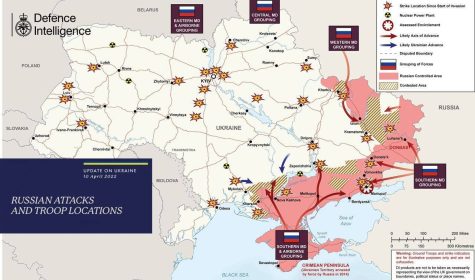
Due to the intense Ukrainian resistance, it was in April when the Russians officially declared that they would shift their focus to seizing control of the Donbas Region (red in the photo above), and withdrew troops from Kyiv and the northern areas of Ukraine along the Belarusian border.
On April 8, Russian missiles struck train stations in the city of Kramatorsk, which resulted in the deaths of over 50 civilians. The train station was full of “women, children, and elderly people trying to flee the fighting.”
President Volodymyr Zelenskyy “Lacking the strength and courage to stand up to us on the battlefield, they are cynically destroying the civilian population.”
The Russians later saw the beginning of what would become one of the many devastating blows when its ship, the Moskva of the Russian’s Black Sea Fleet, was struck and sunk by Ukrainian missiles on the 14th of April.
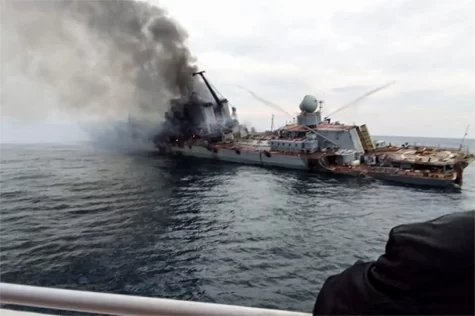
May 2022
Heavy fighting over the city of Kharhiv continued, and the Nordic countries of Sweden and Finland formally applied to join the North Atlantic Treaty Organization (NATO) in response to Russian aggression and the war in Ukraine. It was in late May when the Russians finally seized the city of Mariupol, an important industrial hub and key port city to the Sea of Azov. According to the New York Times, the battle ended “with a siege of the Azovstal steel plant, which had become a symbol of Ukrainian resistance.”
June 2022
The Ukrainian Naval Forces continued to undermine the former might of the Russian Navy when the Russians were forced to withdraw troops from an island in the Black Sea named ‘Snake Island’ when Ukrainian forces recaptured land off Odesa. However, Russia continued to target civilians, which is evident by the missiles which struck a crowded shopping mall in the city of Kremenchuk, killing at least 18 people and wounding another 59 people.
According to weforum.org, a United Nations spokesman called the action ‘deplorable.’ Al Jazeera furthers the UN spokesman’s point when they stated, “the leaders of the G7 have condemned a deadly Russian missile attack on a crowded Ukrainian shopping center as an “abominable” war crime.”
July 2022
Russian forces successfully conquer the city of Lysychansk, the last Ukrainian-held part of the Luhansk Oblast, following weeks of bloody fighting.
Ukrainian Counteroffensive of Russia (August 29 to November 11, 2022)
August 2022
Nothing incredibly notable happened between July and August of 2022 due to a stalemate; however, this stalemate was interrupted by a sudden and powerful Ukrainian counteroffensive. This counteroffensive devastated Russian lines and would continue for the months following. The Ukrainians launched a counteroffensive on the region of Kherson, where they would target military infrastructure in foresight of splitting the only landbridge between the Crimean Peninsula and the Donbas region.
The Ukrainians also attacked an airfield in Crimea alongside multiple ammunition dumps and intrepidly, the brave President Volodymyr Zelenskyy vowed on the 23 of August 2022, that “Ukraine would recapture its annexed peninsula of Crimea from Russia when it chooses and that Kyiv will not consult other countries before doing so.” according to Reuters.com.
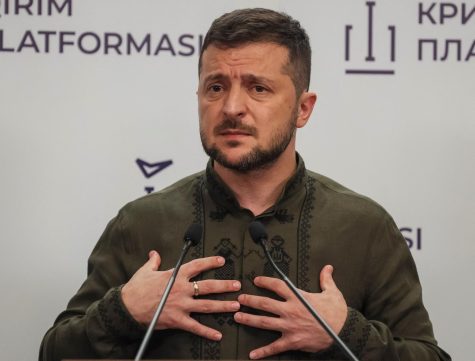
September 2022
Throughout the month of September, Ukrainian forces saw overwhelming success with their rapid counteroffensive against Russia. They seized much of the strategically railroad-rich northeastern Kharkiv region and would later capture the city of Lyman in October. Ukrainian forces continued to push forces toward the city of Kherson.
According to weforum.org, Russian President Vladimir Putin ordered the “partial mobilization of hundreds of thousands of reservists. His decree sparks an exodus of military-age men trying to cross the border into neighboring countries.” This is displayed perfectly in the photo of a traffic jam on the Russian border of Georgia on September 25, 2022.
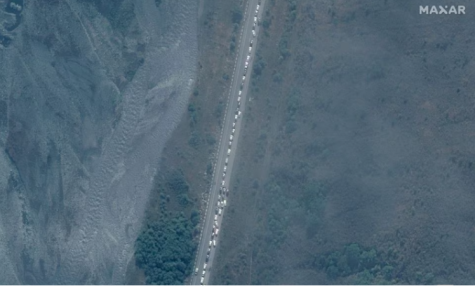
Putin also stated that Russia will officially annex the regions of Donetsk, Luhansk, Zaporizhzhia, and Kherson following “locally held” referendums which were, obviously, a phony sham. This is evident by the preposterous results of 99.2%, 98.4%, 93.1%, and above 87% respectively in favor of being annexed by Russia.
October 2022
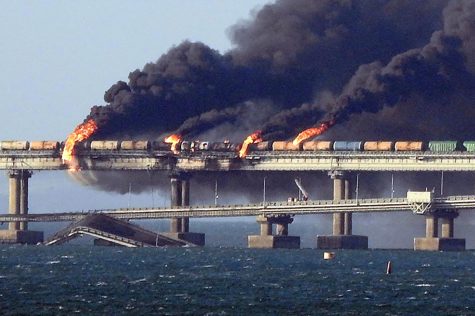
At 06:07, a gargantuan explosion shook the Crimean Peninsula, when the only bridge connecting the peninsula with the Russian mainland exploded and erupted into flames on the 8th of October, parts of the bridge even collapsed and crashed into the sea. The New York Times described the Crimean Bridge as “a critical artery connecting Russian troops” with the Ukrainian homeland. The explosion is likely due to a Ukrainian truck bomb. Russia would soon retaliate with the first artillery barrages on Kyiv in months.
Russian missiles continued to barrage not only Kyiv but other critical energy infrastructures in Ukraine. “The country’s energy minister says at least half of the country’s thermal energy capacity has been hit.” according to weforum.org. Russia would also officially annex the four regions following the phony referendum results.
The Second Stalemate (November 12, 2022, to present day, March 2023)
November 2022
After nearly nine full months of Russian occupation, Russia officially ordered troops to retreat from the city of Kherson, the only regional capital Russia had successfully captured so far. Putin also claimed that Kherson would be one of the four regions that would remain with Russia “forever.” President Zelenskyy called this triumphant milestone “the beginning of the end.” The liberation of Kherson also marked the (perhaps temporary?) end of the Ukrainian counteroffensive.
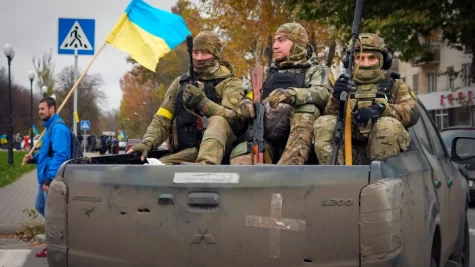
The European Union also looked at ways on how they could help Ukraine’s energy sector following ‘cruel and inhumane’ attacks that have sparked widespread power outages.
However, the Russians dug in on the opposite side of the Dnipro River from Kherson as evidenced by drone footage which may result in a defensive trench-warfare-like continuation of the war there.
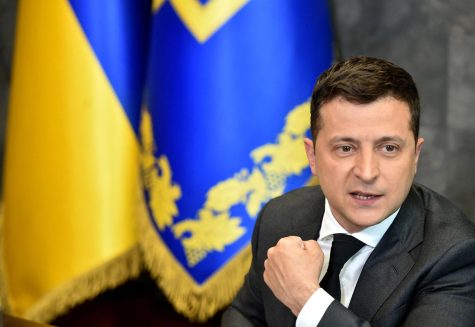
December 2022
Due to the Ukrainian counteroffensive effectively coming to an end, Ukrainian forces launched drone attacks on multiple military bases hundreds of miles in Russian territory according to the New York Times. President Volodymyr Zelenskyy also left the first country for the first time since the war began, coming to the United States to address Congress, stating “aid to Ukraine is an investment in democracy.” Weforum.org adds that “On Christmas Day, Vladimir Putin says Russia is ready to negotiate over Ukraine. However, Kyiv says Moscow isn’t serious about talks and says it will not rest until every Russian soldier is removed from its territory.”
January 2023
With reinforcements pouring in, a brief Russian offensive took place in the early days of January when Russian forces seized the town of Soledar, their first key victories in months, and shift focus to the strategic city of Bakhmut.
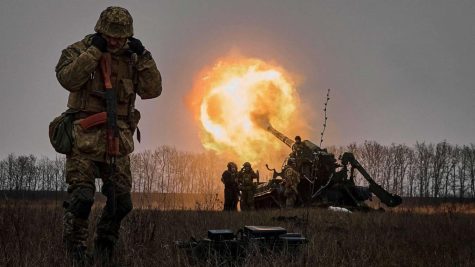
“The world overcame apartheid, the pandemic, the financial crisis … Now the world is fighting Putin. The world will overcome again,” stated President Volodymyr Zelenskyy.
Ukrainian forces also struck a building housing hundreds of Russian troops, which Moscow claims to have caused the death of 89 soldiers, however, Kyiv estimates the death toll is in the hundreds, alongside hundreds more wounded.
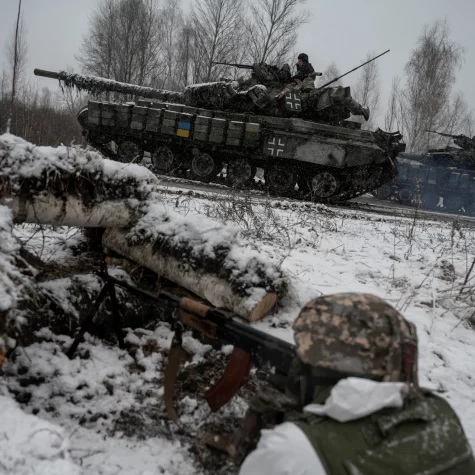
February 2023
The stalemate continues, however, Russian forces continue to edge their way toward the city of Bakhmut, suffering heavy losses along the way. However, President Volodymyr Zelenskyy has made it clear that “Ukraine will not give up on the embattled city of Bakhmut.”
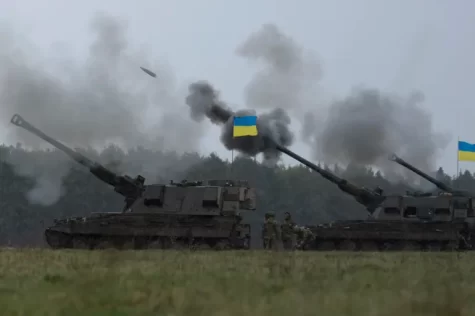
March 2023 (Present)
Russian forces continue to attack eastern Ukraine from the North and South, and Zelenskyy has stated the situation on the frontline is not looking good due to the lack of ammunition and food among his troops. Intense fighting over Bakhmut continues, with Russian forces entering the east side of the city and recently seizing the AZOM metallurgical plant in the north of the city of Bakhmut, according to a video posted by Russian state media and verified by CNN. However, CNN has also recently stated that Russian forces are losing momentum in the city of Bakhmut, Top Commanders alongside President Zelenskyy himself have stated that they will “hit the Russians back in Bakhmut very soon.”
It appears as though the Russo-Ukrainian War, unfortunately, will not end anytime soon. With intense Ukrainian resistance, fierce fighting with Russian forces, the lengthy stalemate, and the uncooperative nature of both countries, this war has proven to be a deadly and devastating one, with around 40,000 deaths on both sides, with civilian deaths alone estimated around 8,000.
Hopefully, the Ukrainian forces will continue to remain strong and defeat the Russian forces and take back their stolen homeland. Slava Ukraini.
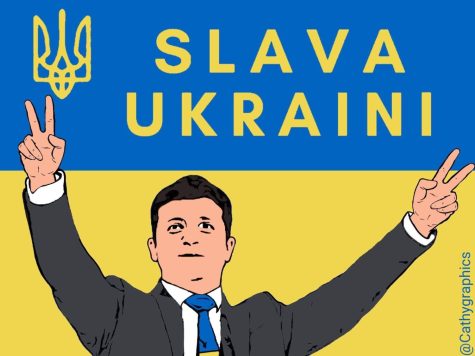
Photos Courtesy of mapchart.net, The Washington Post, EURACTIV, Twitter, NBC News, Reuters, NPR, Al Jazeera, ABC News, and Western Slope Now.

Gavin Gardner is a Senior at Roxbury High School and Editor-In-Chief of the Roxbury Review. He has aspirations of serving at West Point, The United States...

